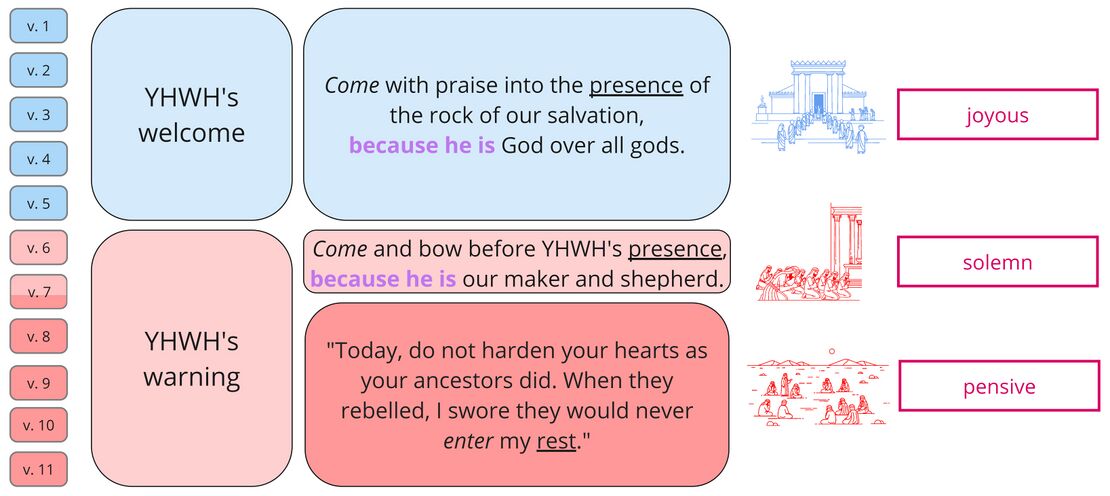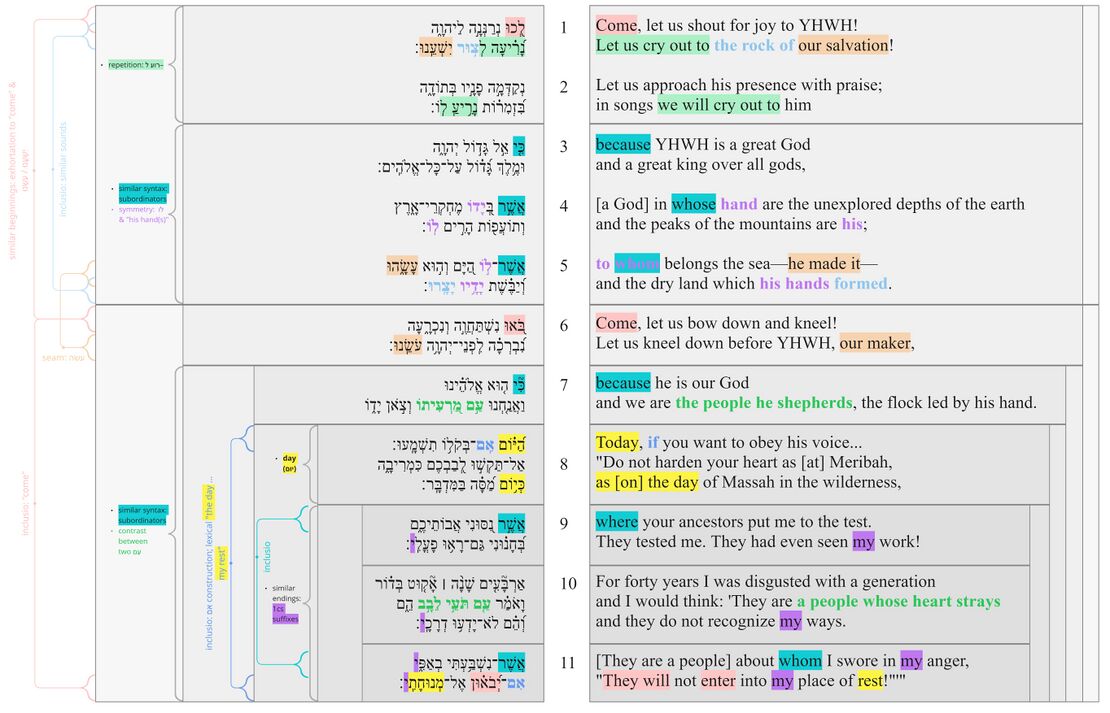Psalm 95 Poetic Structure
Poetic Structure
In poetic structure, we analyse the structure of the psalm beginning at the most basic level of the structure: the line (also known as the “colon” or “hemistich”). Then, based on the perception of patterned similarities (and on the assumption that the whole psalm is structured hierarchically), we argue for the grouping of lines into verses, verses into sub-sections, sub-sections into larger sections, etc. Because patterned similarities might be of various kinds (syntactic, semantic, pragmatic, sonic) the analysis of poetic structure draws on all of the previous layers (especially the Discourse layer).
Poetic Macro-structure
If an emendation or revocalization is preferred, that emendation or revocalization will be marked in the Hebrew text of all the visuals.
| Emendations/Revocalizations legend | |
|---|---|
| *Emended text* | Emended text, text in which the consonants differ from the consonants of the Masoretic text, is indicated by blue asterisks on either side of the emendation. |
| *Revocalized text* | Revocalized text, text in which only the vowels differ from the vowels of the Masoretic text, is indicated by purple asterisks on either side of the revocalization. |
Notes
- Not only does the root בוא provide an inclusio for the second half of the psalm and provide motivation for the alternation to בֹּ֭אוּ (v. 6) from לְ֭כוּ (v. 1), but the latter may also finds its correspondence in the implied *לֹא הָלְכוּ בִדְרָכַי "they did not walk in my ways" in עַ֤ם תֹּעֵ֣י לֵבָ֣ב הֵ֑ם וְ֝הֵ֗ם לֹא־יָדְע֥וּ דְרָכָֽי׃ (v. 10b-c),[1] such that the initial imperatives of the psalm's two halves are brought to a close at the end of the psalm (1a - 10bc // 6 - 11b). Savran also notes that "the close relationship between the היום of v. 7c and the כיום of the trial in the desert (v. 8) is central to the rhetorical strategy of the psalm,"[2] and, similarly, "the meaning of the psalm emerges precisely from this break [v. 7c] in the text."[3] Further yet, the section of v. 7c-11b is bound by הַ֝יּ֗וֹם "the day" and מְנוּחָתִֽי "my rest" (cf. Gen 2:2).
- While some scholarship consider the psalm's two major sections to be determined by the "prophetic" turn in v. 7c,[4] van der Lugt's approach reflects our observations here and understands the two imperatives in vv. 1 and 6 to represent the beginning of the psalm's two sections.[5] See the discussion in van der Lugt,[6] which he prefaces as follows: "Mesmerized by the special character of vv. 8–11, exegetes generally take v. 7d as an independent colon introducing the divine speech ... I will argue that the main caesura in Psalm 95 is not to be found after v. 7c, but after v. 5. At the same time, there are no compelling reasons to separate v. 7d from the preceding strophe."[7] Further, we are in full agreement with his conclusion: "The bipartite structure of Psalm 95 is not based on the difference between a ‘hymn’ and an ‘oracle’, but between God as the Lord above the gods (vv. 1–5) and God as the Shepherd of the people of Israel (vv. 6–11), between ‘heaven’ and ‘earth’."[8]
Line Divisions
Line division divides the poem into lines and line groupings. We determine line divisions based on a combination of external evidence (Masoretic accents, pausal forms, manuscripts) and internal evidence (syntax, prosodic word counting and patterned relation to other lines). Moreover, we indicate line-groupings by using additional spacing.
When line divisions are uncertain, we consult some of the many psalms manuscripts which lay out the text in lines. Then, if a division attested in one of these manuscripts/versions influences our decision to divide the text at a certain point, we place a green symbol (G, DSS, or MT) to the left of the line in question.
| Poetic line division legend | |
|---|---|
| Pausal form | Pausal forms are highlighted in yellow. |
| Accent which typically corresponds to line division | Accents which typically correspond to line divisions are indicated by red text. |
| | | Clause boundaries are indicated by a light gray vertical line in between clauses. |
| G | Line divisions that follow Greek manuscripts are indicated by a bold green G. |
| DSS | Line divisions that follow the Dead Sea Scrolls are indicated by a bold green DSS. |
| M | Line divisions that follow Masoretic manuscripts are indicated by a bold green M. |
| Number of prosodic words | The number of prosodic words are indicated in blue text. |
| Prosodic words greater than 5 | The number of prosodic words if greater than 5 is indicated by bold blue text. |
If an emendation or revocalization is preferred, that emendation or revocalization will be marked in the Hebrew text of all the visuals.
| Emendations/Revocalizations legend | |
|---|---|
| *Emended text* | Emended text, text in which the consonants differ from the consonants of the Masoretic text, is indicated by blue asterisks on either side of the emendation. |
| *Revocalized text* | Revocalized text, text in which only the vowels differ from the vowels of the Masoretic text, is indicated by purple asterisks on either side of the revocalization. |
Notes
- v. 7 – Both Howard and van der Lugt suggest analyzing וְצֹ֣אן יָד֑וֹ as its own line, as reflected also in Alexandrinus and Vaticanus,[9] but not Sinaiticus. Van der Lugt is explicit in his reasoning: "as a break-up of a stereotyped phrase (cf. Pss. 79,13a and 100,3c...)."[10] Nevertheless, the internal evidence (line balance and syntax) evidence seems to support our preferred three-line grouping, found also in the Codex Sinaiticus. Also dispreferred is reading כִּ֘י ה֤וּא אֱלֹהֵ֗ינוּ וַאֲנַ֤חְנוּ עַ֣ם מַ֭רְעִיתוֹ וְצֹ֣אן יָד֑וֹ as one long line, which the Masoretic accents would seem to indicate and which is also read in the Babylonian manuscripts.
- ↑ See Savran 2003, 29.
- ↑ Savran 2003, 32.
- ↑ Le sens du psaume se dégage justement de cette rupture [v. 7c] dans le texte; Van Petegem 2008, 237.
- ↑ See, e.g., Howard 1997, 53-54; Fokkelman 2003, 184.
- ↑ van der Lugt 2014, 62.
- ↑ van der Lugt 2014, 66-69.
- ↑ van der Lugt 2014, 6.
- ↑ van der Lugt 2014, 68.
- ↑ So Rahlfs 1931; see Howard 1997, 54 and van der Lugt 2014, 62.
- ↑ van der Lugt 2014, 62.



